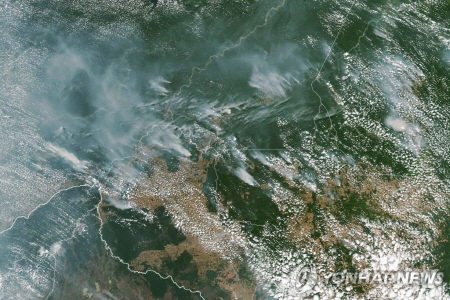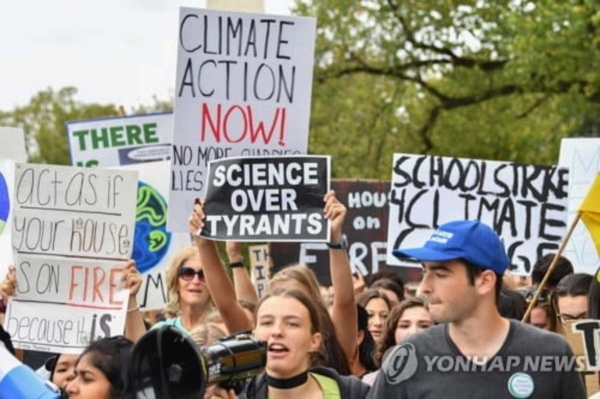소셜미디어, 지구환경보호에 대한 뉴욕대학생 관심 끌어내
지구보호 활동, SNS덕 전세계 논의 확대로 이어지고 있어

[오피니언뉴스=김나현 뉴욕 통신원] 내가 가장 좋아하던 어린 시절의 추억 중 하나는 동물들의 이름을 배우는 것이었다.
나는 야생 동물 백과(Big Book of Wild Animals)를 펼쳐놓고 열심히 "곰! 펭귄! 사자!" 를 외쳤고, 동물원에서 이 동물들을 직접 볼 수 있기를 기대했다. 나는 부모님과 함께 'Animal Planet' 같은 다큐멘터리 TV프로그램을 보면서 동물들의 이름을 알아 맞추는 게임을 하는 것을 즐겼다.
멸종, 나의 아이들이 볼수 없는 동물들
하지만 언제인가는 옛 다큐멘터리를 보다가 내가 전혀 모르는 동물을 본 기억이 있다. 나는 "저 동물은 뭐예요? 내 책에는 없는데" 라고 부모님께 물었고,
"아, 그 동물은 우리가 어릴 적에는 흔히 볼 수 있었는데, 지금은 멸종되었단다"
"멸종이라니요?"
"공룡처럼 지금은 사라져 버렸단다" 하시는 부모님의 답에 나는 고개를 끄덕였다.
부모님 서로 자신들의 어린 시절에 볼 수 있었던 동물들이 나의 세대에는 사라지고 없다는 것이 얼마나 슬픈 일인지에 대해 이야기를 나누었다.
"그 예쁜 새를 정말 좋아했었는데, 안타깝네…"
동물들에 대한 나의 애정은 지금까지도 변함이 없을 뿐만 아니라, 밀렵과 삼림 파괴로 인한 지구의 환경 문제에 대한 우려와 관심은 더 깊어졌다.
나는 종종 부모님과 나눈 대화를 떠올리며, 멸종이라는 것이 과거 공룡의 시대에 국한된 현상이 아니라 현재에서도 충분히 일어날 수 있다는 것을 깨달았다.
미래의 아이들이 내가 부모님에게 물어보았던 것과 같은 질문을 할 때, 어떤 동물이 인간 때문에 멸종돼 더 이상 지구상에 존재하지 않다는 사실을 설명해야 한다는 것은 상상하기조차 싫다.
불행히도 이런 미래는 이미 도래하고 있으며, 나의 걱정은 더 이상 상상이 아닌 현실이 되어가고 있다.
몇 년 전 상아 수집을 위한 무분별한 포획으로 코끼리가 멸종위기종이 되었다는 소식을 접했을 때 너무 가슴이 아팠다.
지난 1년 동안 토목 공사 등을 위해 삼림이 파괴되고 있는 상황에서 나무늘보들이 필사적으로 나무 가지에 매달려 있는 화면을 너무도 많이 보았고, 한달여 전에는 밀렵과 서식지 파괴로 인해 기린도 코끼리와 같이 멸종위기종에 포함될 것이라는 안타까운 소식도 접했다.

인류 생계태 파괴하는 인간들
지난 주에 자연적으로 가장 습한 환경의 아마존 열대우림에 건기와 삼림 벌채로 인한 산불이 약48시간 동안 지속되었다는 것은 더욱 충격적이었다.
우리는 현재 '6번째 대량 멸종'으로 더욱 잘 알려진 '홀로세 멸종위기 (Holocene Extinction)'에 살고 있다. 해가 갈수록 최소 1000에이커 이상 크기의 대형 산불이 기하급수적으로 증가하고 산불 발생기간이 길어지고 있으며, 아마존 열대우림도 산불이 전년보다 85% 증가했다.
이에 관해 본질적으로 가장 중요한 것은 이러한 현상이 인간의 활동에 기인한다는 것이다.
'지구의 허파'라 일컬어지는 아마존 열대우림이 사람으로 인한 산불로 파괴되고 있는 이 현실을 보면, 현재는 300여 마리 밖에 남아있지 않는 Cross River Gorilla를 멸종시키기 위해 인간들이 고릴라의 생태계를 파괴한 것과 똑같은 방법으로 온 인류의 생태계인 이 지구를 인간 자신들이 파괴하고 있다는 말도 안되는 상황이 벌어지고 있는 것이다.
우리는 오락과 부를 위해 동물을 사냥하고, 목축과 농업을 위해 숲을 불을 지른다. 동물인형을 껴안고 예뻐하는 바로 그 손에 의해 실제 동물들이 위험에 처해지고 있다.
나의 손자 손녀가 기린이라는 동물을 실제로 보지 못해 얼룩 무늬에 긴목 가진 동물이 무엇인지 물어 볼 지도 있다 – 현재 야생에 살고 있는 기린은 6만8000마리에 불과하며, 지난 30년 동안 40% 감소한 개체수다.
우리가 사는 이 지구의 생태계가 계속 파괴되고 있다는 소식을 매일 듣는다는 것은 너무나도 가슴 아프고 충격적인 현실이다. 하지만 이런 변화가 일어나고 있다는 것을 아는 것은 매우 중요하며, 나도 대다수의 미국 대학생들처럼 이런 정보 대부분을 소셜미디어에서 얻고 있다.
아마존 열대우림의 산불 사태는 상당한 기간 동안 소셜미디어의 검색어 상위권에 있었고, 많은 미국인들에게 경각심을 불러 일으켰다.
우리들은 이 지구상에서 일어나고 있는 재난에 대해 '동의', '좋아요', '공유' 등의 방법으로 이런 상황을 세상에 전달하고 있다.
우리 세대는 기후 변화와 동물 밀거래/밀렵과 같은 이슈들에 대해 활발하게 의견을 주고받으며, 요즘 문화의 큰 부분인 소셜미디어 덕분에 '6번째 대량 멸종' 같은 사안들도 일반적인 상식으로 자리잡게 됐다.
또한 야생동물보호를 지원하는 온라인 커뮤니티에 많은 사람들이 관심아래 참여하는 것은 고무적인 현상이라고 생각된다. 예를 들어, 여러 소셜미디어에서 에티오피아 (Ethiopia)가 현재 기후 변화에 대응하고 삼림의 재녹화를 위해 하루만에 3억 5천만 그루 이상의 나무를 심었다는 기사를 접하기도 했다.
이는 나처럼 지구 환경 보호에 관심있는 사람들에게는 너무나 반가운 소식이었고, 말처럼 쉽진 않겠지만, 에티오피아 같은 후발개발도상 국가의 이런 훌륭한 노력에 선진국들도 동참해야 한다는 의견이 많은 소셜미디어 커뮤니티에서 급속히 퍼졌다.

소셜미디어, 지구환경 보호에 전세계 논의 끌어내
소셜 미디어는 대학생들 사이에서는 홍보를 위한 탁월한 수단이다. 'Save the Turtles(거북이들을 살리자)'라는 운동이 활발해지고 있고, 이는 금속 빨대의 대중화의 기폭제가 되었다. 바다로 흘러들어가 거북이들을 죽이던 수백만의 플라스틱 빨대들이 금속 빨대로 대체되었다.
매우 도시적인 뉴욕대학교 (NYU)의 많은 학생들과 함께 나도 금속 빨대를 애용한다. 이 금속 빨대는 패션 아이템이 되었을 뿐만아니라, 환경을 생각하는 자선적인 목적으로 많은 사람들에게 큰 호응을 얻고 있다. 소셜미디어와 학교 캠퍼스에서 유행과 더불어 자선적인 의미를 가지고 있는 품목들에게는 특별한 매력이 있는 것은 분명하다.
나처럼 많은 미국 대학생들은 생태계의 변화와 이에 관한 도전에 주목하고 있다. 소셜미디어는 다른 목적도 갖고 있지만, 나는 우리 지구상에서 무슨 일이 일어나고 있는지에 대해 의견을 나누는 환경 보호 커뮤니티를 매우 지지한다. 이러한 활동이 국경을넘어서 비단 미국 대학생들 사이의 대화가 아닌, 전세계의 학생들이 참여해 더 폭넓고 진취적인 논의로 확산되기를 기대한다.
Waking Up to the Sound of Fire
One of my fondest childhood memories is learning the names of animals. I’d open my Big Book of Wild Animals and eagerly yell ”Bear! Penguin! Lion!” – and look forward to the next time I could see these animals at the zoo. I loved watching documentaries like Animal Planet with my parents and playing this name calling game. But, I distinctly have a memory of watching an old documentary with my parents and seeing an animal I could not identify. I asked, “What is that? It’s not in my book.”
“Ahh sweetie, that animal was common in our day, but now its extinct.”
“Extinct?”
“They’re gone, like the dinosaurs”
And I nodded. My parents discussed between themselves how strange yet sad it was that animals in their own youth would never be seen by my generation.
“How sad, I really liked that bird. It was so pretty.”
My love for animals still continue to this day and have deepened to an interest and concern for the environment, especially because of the alarming poaching and deforestation taking place. So I often think about the conversation I had with my parents, and it is bizarre to think of extinction as a possibility in the present day instead of something in the past. It’s even harder to imagine children of our future asking the same question I had once asked my parents, and having to explain to them that the animal isn’t here anymore because it was driven to extinction by us, humans.
Unfortunately, this future is too imminent and these thoughts I had are no longer imagination but fact. You can picture how heart broken I was several years ago when I heard that elephants had made the endangered species list because they are hunted aggressively for their tusks. In the past year, I’ve seen one too many videos of sloths gripping onto the trees they inhabit as if- literally- their lives depended on it as their forests are run over and cleared for construction. And it was just a month ago when I learned that giraffes, too, would be joining the elephants as an endangered species also because of poaching and habitat loss. I was even more bewildered to learn that the Amazon rainforest, a naturally extreme humid environment, was on fire for approximately 48 hours just last week due to the combination of the dry season and deforestation.
We are currently living in the Holocene extinction, better known as the 6th mass extinction, an ongoing extinction crisis of species. Furthermore, with each passing year, the number of wildfires (minimum 1000 acres) exponentially grows and wildfire seasons become longer- the Amazon rainforest has seen an 85% increase in forest fires from last year. What’s crucial, however, is that all are essentially caused and described by human activity. The irony behind purposefully setting fire to “the lungs of the world”, the Amazon rainforest, is ridiculous because we are destroying our own home, the planet, the same way we choose to annihilate, say, the forests of the Cross River Gorilla (only 300 of its species are left). We choose to hunt animals for pleasure and trade, and set our forests on fire for ranching and farming. The very stuffed animals that we cuddled are put in danger by the very same hands that gripped the dolls. What if my own grandchildren asked me what that spotted animal with the long neck was? “A giraffe, sweetie”- There are reportedly only 68,000 giraffes left in the wild, a 40% decrease in the past thirty years.
It’s absolutely heartbreaking and overwhelming to hear updates on the overall decline in quality of our planet everyday. However, it is absolutely necessary to be well informed to see a change, and most of the information I get is all obtained just from scrolling through social media, which is the same for numerous American college students. The Amazon rainforest fires were a trending headline for quite a while, and a wakeup call for people all over the country. We are aware of the damage that is happening on earth, and with each view, like, comment, and repost the knowledge spreads. It’s incredible how people my age have discussions about things like climate change and animal trafficking, and because social media is a huge part of our culture the sixth mass extinction is also becoming common knowledge for us. It’s also assuring to see how many people care and contribute to the online communities that support wildlife conservation. For example, I read on multiple social media platforms that Ethiopia had planted over 350 million trees in a single day to tackle climate change and initiate reforestation. This was huge for environmentally conscious people like myself, and although easier said than done, many social media communities remarked that if an underdeveloped country had acted so heroically, what’s to say that more developed countries couldn’t do the same?
Social media is also an excellent source for advertisement amongst college students. The Save the Turtles movement has been on the rise, and with it the metal straw was popularized. Millions of the traditional plastic straws end up in the ocean only to harm and kill turtles, and have been replaced with metal straws. As a student in New York University, a very chic city school, I, along with many other students, use these metal straws. Not only are they a fashion item, but also a philanthropic useful one that gives people even more motivation to buy them. There is definitely something about the combination of a trending item on social media (and on campus) that has a deeper benevolent meaning that draws people to it.
Many American college students like myself have our eyes and ears open towards ecological challenges. Although social media definitely has different purposes, I really love the conservationist community within it that actually widely informs people about what is going on in our planet. Hopefully, this influence is able go transnational so that the discussions between American college students can broaden into a wider better-cultivated conversation with international students.
저작권자 © 오피니언뉴스 무단전재 및 재배포 금지


